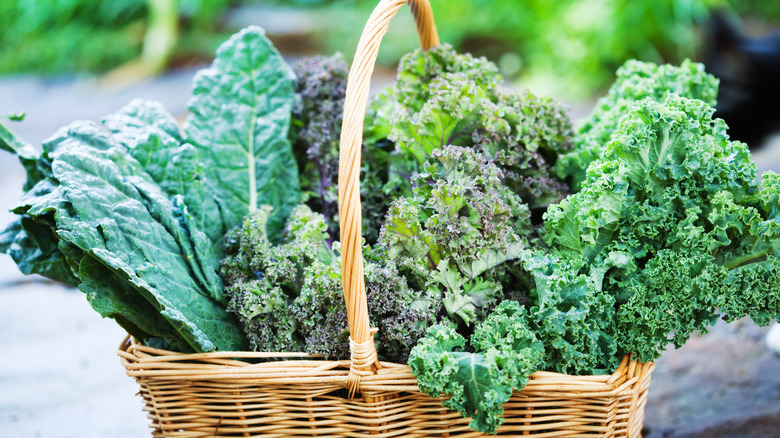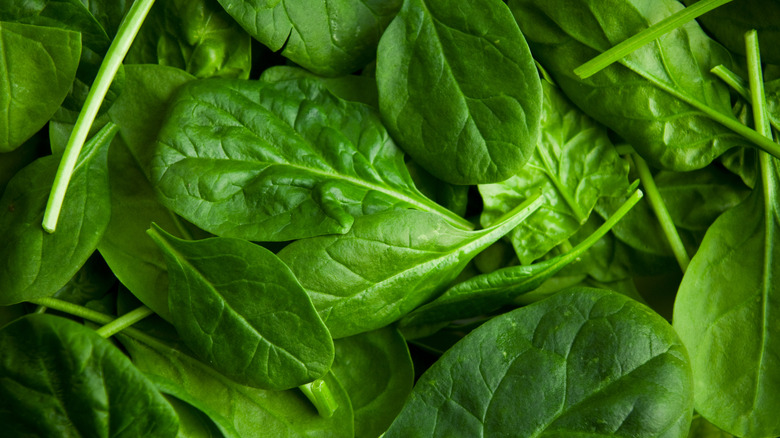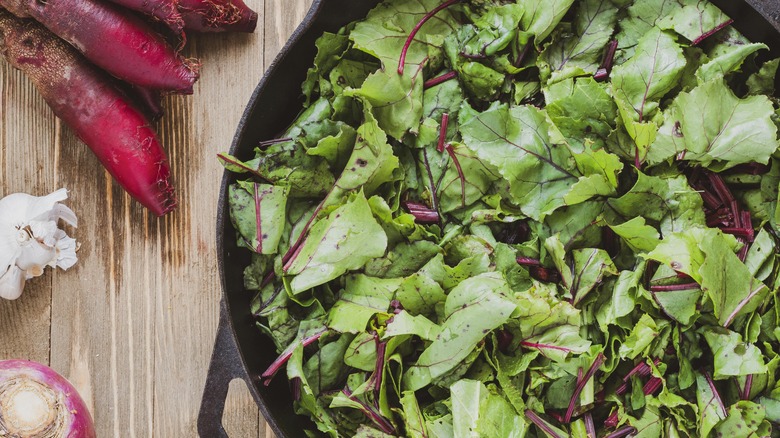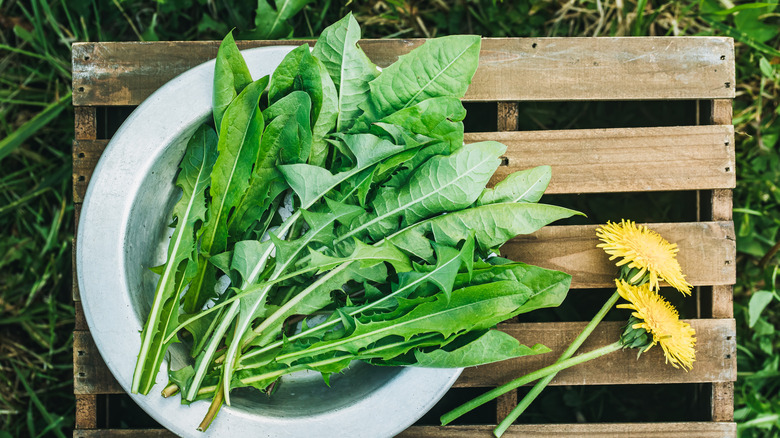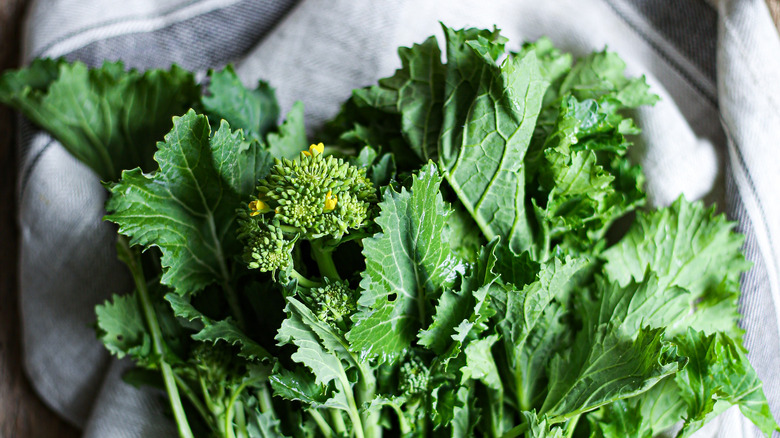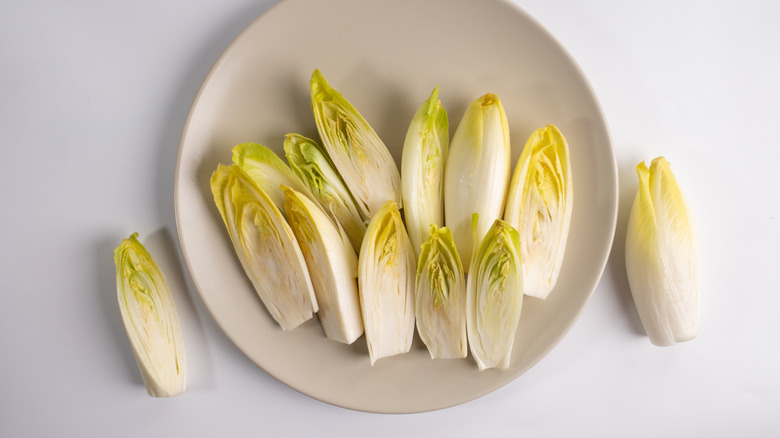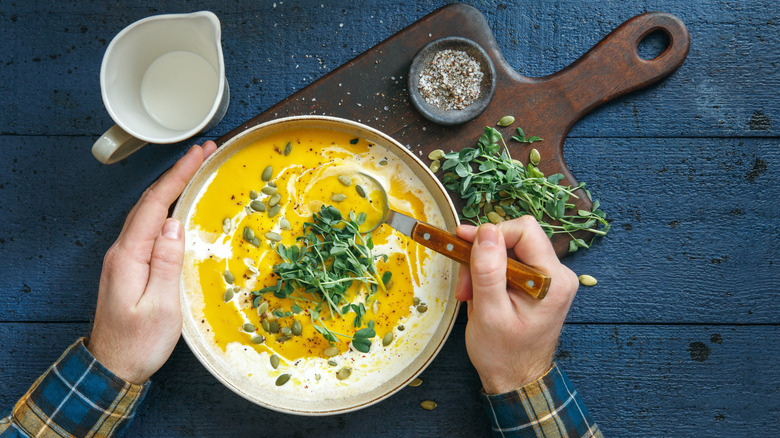15 Leafy Greens You Should Be Cooking With (And How To Use Them)
Ahh, leafy greens. Everyone would like to say they're downing them like candy. But the wilted container of spring mix in the back of our refrigerators says otherwise. According to the CDC, only one in 10 Americans eat enough fruits and vegetables. While that side salad with dinner or a handful of spinach in your morning smoothie does make a difference, there is so much more we can do with leafy greens! Venture outside of your boring iceberg lettuce slumber. Educate yourself about the exuberant amount of leafy greens to cook with and learn how to best utilize them.
Leafy greens are loaded with health benefits. They are versatile, diverse in flavor and texture, and can be incorporated into almost any savory meal. For those who recoil at the thought of steamed spinach, there are plenty of ways to sneak leafy greens into your diet without having to eat them by the forkful. Let's look beyond lettuce and expand our leafy green horizons.
Kale
While kale, Brussels sprouts, and cauliflower were once America's rejects, they've been rebranded in the 21st century as trendy and desirable. Kale can be readily found at gastropubs baked into crispy chips or at a hipster diner blended into almond milkshakes. There are plenty of different types of kale, but you're probably most familiar with curly kale.
If you're sticking to a simple salad, massage your kale by oiling and pressing the leaves between your fingers until the fibers soften and they turn dark green. You'll also want to consider stripping away the stems from the leaves. But don't throw them out, as there are several ways to use leftover kale stems. This process will make the salad tender and less bitey. Kale can also be sautéed in oil and garlic as a side or baked at a high temperature with oil and nutritional yeast to craft crunchy chips. Kale can be blended into sauces and pasta dishes, and even raw into smoothies.
Broccoli rabe
Broccoli rabe, also known as rapini, has a reputation for being served with butter at fancy steakhouses. However, the leafy green has a wide range of use. While you might think it's part of a broccoli plant due to its appearance, it's more closely related to the turnip — resulting in its bitter taste. Still, its bud clusters, long stems, and leaves look similar to broccolini.
To eliminate its bitter undertones, consider blanching broccoli rabe. Since the bitter compound found in the leafy green, glucosinolate, is water soluble, the blanching process helps to release some of its sting from the plant. Be sure to let it cook briefly in boiling water, as there's nothing worse than soggy and mushy leafy greens. After it's been removed from the water, feel free to sauté it in fat and seasoning, roast it in the oven briefly, or enjoy it as is!
Spinach
No matter what rock you live under, your diet, or where you buy groceries, you have likely eaten plenty of spinach over your lifetime. It's easy to work with a dark leafy green that's eaten raw just as much as it's enjoyed cooked. Unlike most leafy greens, you can find spinach in comfort foods like spinach dip, ricotta stuffed shells, and classic creamed spinach.
Raw spinach is nearly flavorless, so it's easy to blend into a fruit smoothie or pair with fruit in salads. Some people throw a handful of spinach into their baked goods or oatmeal because cooked spinach doesn't have a dominating flavor. Include it in your stir fries, pasta dishes, sauces, and bakes to add a nutritional boost without changing your dish's composition. If you plan to cook spinach, note that it can get soggy when overdone. If you're planning on cooking spinach for long periods, it's best to mince it up beforehand and mix it with something sturdy like cheese.
Cabbage
Cabbage is a cruciferous vegetable that is often served boiled with dumplings and corned beef, fermented, or minced and mixed with mayonnaise as slaw. While we love cabbage in all forms, there are plenty of other ways to enjoy its sturdy layers. In its raw form, it's tough with a peppery and almost mildly spicy flavor, and the red variety carries more intensity. When cooked, it's buttery with sweet undertones.
Meat dishes tend to take center stage when it comes to dinner, but cabbage is one of those vegetables that can hold its own as the star. You should be cooking cabbage steaks more often as they are filling, dense, and can be flavored to your liking. For an easy Asian-themed side dish, consider sautéing chopped green cabbage with ginger, garlic, and cashews. Make your own sauerkraut by massaging shredded cabbage with salt and letting it ferment in its juice. The possibilities for cooking cabbage are endless!
Collard greens
Let's take a trip down south and explore one of the healthiest and least expensive greens out there: collard greens. This vegetable is notorious for being cooked for hours in broth with bacon and seasonings. During this process, the leafy green breaks down and becomes tender. There are plenty of other unexpected ways to use collard greens in everyday cuisine, including in stuffed egg rolls, quesadillas, quiches, and dips. Use classically seasoned and cooked collard greens or simply sauté them in butter or olive oil.
Collard green's raw leaves are quite crunchy and a bit bitter like kale and can be used in several ways. After you remove its stem, stuff your leaves with sandwich fillings, and roll the contents up like a wrap. You can also blanch the leaves before doing this to remove some of the bitterness — making them slightly more flexible. Just a brief plunge in the boiling water will do, especially if you want the leaf to keep its structure.
Swiss chard
Swiss chard is popular, not only for its bright and colorful stems but also for its sweet undertones. While Swiss chard leaves are deep green, the stems range in color from yellow and orange to pink and red. For those that aren't quite so sure about scooping up a fork full of cooked greens, start with this sweet and delicious variety.
Since this flavorful leafy green is not quite as tough as kale nor as tender as spinach, it's a good idea to chop it up. Consider dicing the stem, and slicing the leaves into thin strips before cooking them. Add the stems first to a pan with hot oil. Flavor with a little tamari or sea salt, and add a splash of apple cider vinegar to bring out the natural sweetness as the vinegar cooks off. For those who plan to use only the leaves, there are several ways to use leftover chard stems – including pickling, a chopped garnish, or mincing them raw for a crunchy addition to salads.
Mustard greens
There are plenty of plants out there where it's easy to assume that once we've harvested all we need from them, we can compost the rest. However, it's most likely that the entire plant can be used and should be used. We are making a case for mustard greens, that come from (you guessed it) the plant that gives us mustard seeds. Like mustard, the leaves are a bit peppery but tend to be less bitter than kale, rapini, and dandelion greens.
You can enjoy mustard greens raw or cooked. Usually, the younger leaves are enjoyed raw in a salad, while the more mature greens typically find themselves in a sauté pan alongside aromatics and fat like butter or olive oil. Mustard greens can be swapped for collard greens in a typical southern recipe and used in place of Swiss chard for a bolder and a savory and peppery flavor.
Beet greens
Who here is surprised to hear that beet greens are sweet? Since much of the sugar processed in America comes from beets, it should be no shock that the entire plant is rich in natural sugars. The plant has a bright beet-purple stem and light green leaves and can be bought either attached to its delicious root or on its own.
But what exactly do beet greens taste like? How do you cook with them? Like beets, its greens are slightly earthy, mild, and sweet. This means that if you aren't a big fan of beets, then you may not enjoy their green leaves either. The greens can be eaten raw or cooked, and become sweeter the longer that they're exposed to heat. Fair warning: Be sure not to overcook them to the point where they become mushy! Consider using them raw and chopped in salads. Or cook them up in stir fries, lasagna, or tetrazzini.
Dandelion greens
Even if you didn't have the time to plant your own vegetable garden this year (or if your thumb has never been green), don't be disappointed. You still have the opportunity to harvest fresh greens from your backyard. Dandelions are edible and eating raw dandelions cannot make you sick. Enjoy their bright yellow flowers and their leafy greens. However, the stems should be avoided. The greens, in particular, are slightly bitter, but pleasant and tender. Pair them with sweet vinaigrettes with maple syrup or honey to mellow them out when you're cooking.
Try a simple dandelion greens recipe using a few ingredients like extra virgin olive oil, garlic powder, pepper, salt, and parmesan cheese. Delicately sauté the leaves in olive oil and include other ingredients for additional flavor — leaving parmesan for last once the greens have been removed from the heat. Who knew backyard scavenging could be so easy?
Turnip greens
Turnip greens have a similar flavor to their root. With slight peppery undertones that transform depending on the season, these leafy vegetables are on the spicier and zipper side. For those of you who prefer arugula to spinach, or enjoy condiments like mustard and horseradish, these greens exhibit a mellow version of such flavors with just a hint of underlying sweetness.
How do you cook them? Raw turnip greens can be cut into bite-sized pieces and incorporated into salads or used as a spicy garnish. But one thing you need to know about turnip greens is that they are just as enjoyable — if not more — when cooked. Especially if you find the raw version to be too bitter, try blanching them briefly or serving them with a citrus-based sauce to tamp down the acidity taste. Buy them attached to the turnip or separately. Enjoy their rooty flavors, cooked, or raw — especially when they are in season.
Endives
Endives are a distinctive leafy green, shaped similarly to a narrow football, and packed with neatly layered leaves like iceberg lettuce. Like cabbage, endives come in both a light yellow-green shade and deep purple-red. The leafy green is pleasantly bitter with a sharp aftertaste. They also have a crunchy, watery mouthfeel, and pair well with cheese. The leaves are more tender than cabbage and chewier than iceberg lettuce. Endives can be shaved and enjoyed raw in salads, sliced and grilled, braised, or seared.
Consider slicing endives in half, tip to base, and searing them in a pan, cut side down. Use citrus fruits and bold flavors like orange and ginger to complement their intensity, and be sure to let the portion of the endive that's in contact with the pan caramelize. Due to their structure, you can use the outer leaves as boats, and stuff them with cheeses, meats, and other vegetables — resembling a dish like stuffed peppers.
Watercress
Unlike many of the leafy greens you may find on your plate, watercress is an aquatic plant. This leafy green grows in water, typically in shallow streams. Their stems are hollow and float, and they can be recognized by their round leaves and white flowers. But don't worry, watercress doesn't have any fishy, briny, or boggy undertones of flavor. Instead, the vegetable tastes fresh and sweet — becoming more flavorful as the plant matures.
Most of the time, watercress is eaten raw in salads or used as a bright and fresh garnish. However, it can be quite enjoyable cooked, as this leafy green captures the flavor of its sauces beautifully and becomes more tender as it's cooked — not unlike endives. Consider using it in summer dishes like grilled salmon with a watercress and pea salad. Pair it with light and mild flavors, like soft cheeses, nuts, seafood, other vegetables, and strawberries.
Bok choy
Bok choy is a leafy green you should be cooking with that often goes overlooked. You may have enjoyed it in Asian cooking before — perhaps diced up with a stir fry or seared and added to a bowl of pho. This green has a watery and almost celery-like flavor with subtly cabbage-like undertones. Its stems are almost entirely flavorless, while the leaves carry a subtle but pleasing bitterness. For an irresistible braised leafy green side, read up on the tips you need to know when cooking with bok choy!
This vegetable comes in several varieties, but most grocery stores will carry a large head and baby bok choy — which is about the size of your palm. This baby bok choy can be sliced tip to base and placed cut-side-down in a pan for searing and braising. Typically, the larger variety is diced and used in stir-fries, but both make an incredibly flavorful side when simmered in a little oil and tamari. You may add a splash of water to help the green steam fully but don't be afraid to let parts of it crisp up! Its layers will capture the sauce well, and make for a beautiful presentation.
Arugula
Arugula is gaining popularity as a salad foundation. When enjoyed fresh, it's peppery — a green that's more robust than tender lettuce. If you grow your own, it's vital to know that arugula gets spicier the longer it matures. If you want a milder vegetable, harvest baby arugula. Typically, people serve arugula raw but it is often paired with hot dishes as it holds up well and tastes pleasant. You may find arugula mixed into your pasta or as a garnish on pizza. The vegetable is robust enough that it blends well into sauces like pesto due to its distinct earthy flavor.
The little leaves are small and narrow oak leaves (for all of you outdoorsy folks). You can typically find the vegetable pre-washed and packaged with salad greens at almost any grocery store. It stores well and for quite a while. For those of you guilty of letting your greens go bad, consider giving arugula a change. If you've never tried this peppery green, then try it in your next salad.
Microgreens
If you hear the term "micro-greens" often, then you probably enjoy going to a co-op, farmers market, and foodie scenes. Micro-greens have gained popularity for their nutrient density and aesthetic appeal. While sprouts have been all the rage for quite some time, micro-greens are slightly matured sprouts that have spread their leaves.
There are a variety of micro-greens — which refers to the plant's stage of life not its family in the plant kingdom. Pea shoots are a common micro-green and there are several ways to eat them. But there's also find broccoli, kale, and radish micro-greens, too. Like most leafy greens, they can be cooked or eaten raw. Top your burgers with micro greens or use them as a garnish in soup. You could also them to your pesto for a nutrient-packed spread. Most have a refreshing grassy flavor. Depending on the species, they can also have sweet, bitter, and nutty undertones.

